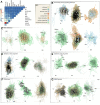This is a preprint.
Chromosome-level genomes of multicellular algal sisters to land plants illuminate signaling network evolution
- PMID: 36778228
- PMCID: PMC9915684
- DOI: 10.1101/2023.01.31.526407
Chromosome-level genomes of multicellular algal sisters to land plants illuminate signaling network evolution
Update in
-
Genomes of multicellular algal sisters to land plants illuminate signaling network evolution.Nat Genet. 2024 May;56(5):1018-1031. doi: 10.1038/s41588-024-01737-3. Epub 2024 May 1. Nat Genet. 2024. PMID: 38693345 Free PMC article.
Abstract
The filamentous and unicellular algae of the class Zygnematophyceae are the closest algal relatives of land plants. Inferring the properties of the last common ancestor shared by these algae and land plants allows us to identify decisive traits that enabled the conquest of land by plants. We sequenced four genomes of filamentous Zygnematophyceae (three strains of Zygnema circumcarinatum and one strain of Z. cylindricum) and generated chromosome-scale assemblies for all strains of the emerging model system Z. circumcarinatum. Comparative genomic analyses reveal expanded genes for signaling cascades, environmental response, and intracellular trafficking that we associate with multicellularity. Gene family analyses suggest that Zygnematophyceae share all the major enzymes with land plants for cell wall polysaccharide synthesis, degradation, and modifications; most of the enzymes for cell wall innovations, especially for polysaccharide backbone synthesis, were gained more than 700 million years ago. In Zygnematophyceae, these enzyme families expanded, forming co-expressed modules. Transcriptomic profiling of over 19 growth conditions combined with co-expression network analyses uncover cohorts of genes that unite environmental signaling with multicellular developmental programs. Our data shed light on a molecular chassis that balances environmental response and growth modulation across more than 600 million years of streptophyte evolution.
Conflict of interest statement
Declaration of Interests The authors declare no competing interests.
Figures






References
-
- Banks J.A., Nishiyama T., Hasebe M., Bowman J.L., Gribskov M., DePamphilis C., Albert V.A., Aono N., Aoyama T., Ambrose B.A., et al. (2011). The selaginella genome identifies genetic changes associated with the evolution of vascular plants. Science 332, 960–963. 10.1126/science.1203810 - DOI - PMC - PubMed
Publication types
Grants and funding
LinkOut - more resources
Full Text Sources
